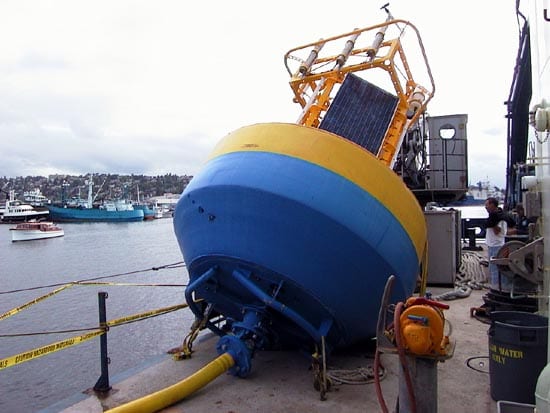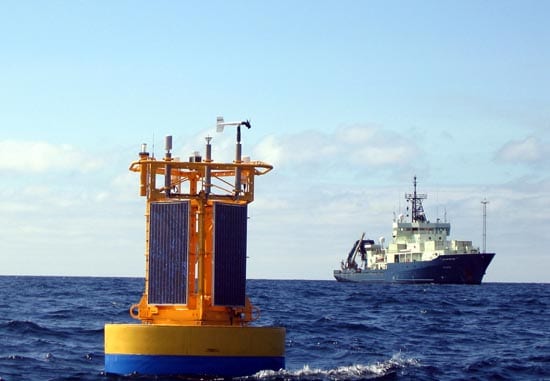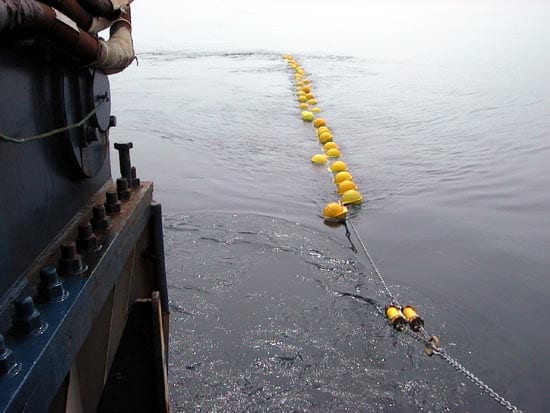Nootka Buoy
What is it and why do we use it?
The Nootka buoy offers scientists the equivalent of a wireless hotspot in the middle of the deep ocean. The only catch is that the radio waves we use to get online at an Internet café can’t travel through water. Instead, Nootka uses acoustic telemetry to send information through the water in bursts of sound waves. A computer mounted on the buoy receives data from up to 15 instruments lying on the sea bottom within about a 20-square-kilometer area (7.7 square miles).
A wireless connection to the deep is useful because it means scientists can install the buoy and then add instruments later on. They can also spread their instruments around a larger expanse of sea floor, rather than clustering them at the base of the buoy’s mooring.
Scientists envision “acoustically linked deepwater buoys” like Nootka working almost anywhere in the world. Nootka’s first deployment was in 2,362 m of water off Vancouver Island, British Columbia, Canada. Several times each day, the buoy received reports from an ocean-bottom seismometer monitoring the Nootka fault and from an array of instruments monitoring a cold seep.
How does an acoustically linked buoy work?
Instruments installed on the sea floor collect data, digitally compress it and store it in memory. One or a few times per day, a computer on the Nootka buoy contacts the instrument using an acoustic modem and asks for its data. The buoy then beams the data (a total of 500 kb to 1 Mb per day) back home using the Iridium satellite network.
The buoy gets its energy supply from solar panels (backed up by 512 D-cell batteries to get it through long cloudy spells). Instruments on the sea floor have to carry only enough batteries to power themselves and to send data up to the buoy.
The buoy can talk back to the instruments, allowing scientists to change settings on the sensors if they need to. For example, an ocean-bottom seismometer listens for tremors, recording the data at two levels of detail. To save power, it normally sends only the lower-precision data back to the buoy. But after a significant earthquake, scientists can instruct the sensor to report the higher-resolution data, so they can monitor aftershocks.
What have we learned using this instrument?
Nootka finished its first deployment in July 2005. During a year at sea, it relayed data from instruments monitoring seismic activity and a cold seep along the Nootka Fault off Vancouver Island, Canada.
An early malfunction illustrated the value of the two-way communication system. A month after Nootka’s deployment, one of the data receivers on the buoy failed. The team logged in over the satellite connection and reprogrammed the computer to use a different data receiver. The software repair took several tense weeks of programming. But it allowed the scientists to recover contact with their instrument without having to launch an emergency repair cruise.
What platforms are involved?
Nootka itself is a platform that supports up to 15 wirelessly connected instruments. Like other moored buoys, Nootka’s hardware - anchor, cables, floats, batteries - requires annual maintenance visits from an oceanographic ship.
Advantages
Lower cost. Connecting instruments by wire to moored buoys costs 2 to 4 times more than using acoustic telemetry. That’s because they require miles of expensive data cables, and the tricky installation at the sea floor has to be done by remotely operated vehicles. Cabled observatories, which are linked directly to shore by broadband data cables and a permanent power supply, are even more expensive.
Flexibility in design. Wireless connections free up the schedule for launching separate instruments: with a quick reprogramming of the buoy computer, a scientist can establish a data connection to a newly deployed sensor. Sensors can be spread out over wider areas than would be feasible with wired connections.
Real-time data. Before acoustic modems and satellite links, sea-bottom sensors had to store data as they collected it. Scientists had to wait up to a year before they could look at what their instruments had recorded.
Limitations
Low data transfer. Engineers continue to improve the capability of acoustic modems. But the physical limitations of sound in water mean the modems are still nowhere near the speeds a broadband Internet user is used to. The Nootka buoy can receive about 1 Mb of data per day from instruments on the sea floor below. A computer might exchange that much information in just a few minutes of Web surfing.
Battery life. With solar power keeping the buoy up and running, the main factor limiting how long a wireless buoy system can run at a stretch is battery life. A typical battery supply can run a sensor and power the acoustic modem for about a year before it has to be hauled up and replaced.
Sources
Dan Frye, Senior Research Specialist, Applied Ocean Physics and Engineering, WHOI.
D. Frye, J. Ware, M. Grund, J. Partan, P. Koski, S. Singh, L. Freitag, J. Collins, R. Detrick. An acoustically linked deep-ocean observatory. WHOI, Woods Hole, MA. (see link at right)
See Also
Going Wireless in the Deep Blue
Deploying instruments to monitor the ocean is one thing. Getting daily reports from them is another. From Oceanus magazine.
Data from the Nootka Buoy
Access to the actual data that Nootka beamed home to WHOI scientists
Acoustic Communications at Woods Hole
More about research and development into acoustic communication at WHOI



